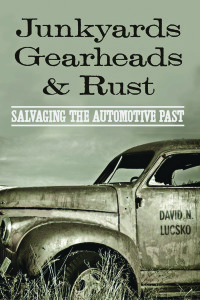
David N. Lucsko offers up a compelling behind-the-scenes tour of salvage yards and derelict cars across America, particularly the Southwest, as seen through the eyes of a self-confessed “gearhead” and all those passionate about restoring classic cars. Junkyards, Gearheads & Rust: Salvaging the Automotive Past surveys the world of taking apart ruined cars and selling second-hand parts as well as looking at the car as art and tight-knit community of car enthusiasts. David, an associate professor of history at Auburn University, also wrote The Business of Speed: The Hot Rod Industry in America, 1915–1990, 2008.
Why did you decide to write this book?
For as long as I can remember, I’ve been fascinated by salvage yards. The toy I wanted most the first Christmas I can remember was Clyde’s Car Crusher, a toy junkyard setup that let you form cars out of foil and then crush them in a miniature junkyard crusher. I didn’t get that toy — probably because I was way too little at the time for it! — but the following year I sort of got what I wanted: we moved to a new house, and out of my new bedroom window I could just make out over the horizon the cranes at a nearby car salvage yard. So I wasn’t able to “play junkyard” in my room, but I could watch the cranes from my window. For a little kid who was fascinated by salvage yards, it was heaven.
I’ve also been a car enthusiast for as long as I can remember, and as I grew up and started working on old cars, I started to visit salvage yards for odds and ends. I was also a voracious consumer of car magazines, in which rags-to-riches stories of “junkyard finds” abounded. So basically, I grew up working on cars and reading about them, and trips to salvage yards were part and parcel of that experience. It was something that I took for granted; just part of the experience of being a gearhead.
In light of what was then — and still is — a fast-growing area of research within the history of technology concerned with reuse and recycling, I was convinced that I could do a follow-up to The Business of Speed that would look at the relationship between car enthusiasts and salvage yards in the United States. Not a history of the scrap-metal business, nor a straightforward history of the auto salvage parts business, but a history of car enthusiasts and salvage yards. And I’m glad I chose to do so: researching and writing this book has been tremendously rewarding, and tremendously fun.
What were some of the most surprising things you learned while writing/researching the book?
To me the most surprising was the extent to which the specialty salvage business is concentrated in the American Southwest. Here I mean that part of the salvage industry that caters specifically to car enthusiasts. I knew going in that parts from Arizona and California are coveted by enthusiasts, but the extent to which Arizona, California and other arid states are statistically overrepresented in the business really surprised me. Again, I knew they would be important, but I didn’t know how important.
What is new about your book/research that sets it apart from other books in the field?
Junkyards, Gearheads & Rust is less concerned with the scrap-metal recycling business and more concerned with the direct reuse and repurposing of parts and cars from salvage yards. So unlike previous scholarship, this book emphasizes what happens to cars after they are no longer on the road, but before they head into the shredder and the scrap-metal furnace. It is a story of creative reuse and adaptation: of customizers using metal from wrecked cars in their endeavors, of hot rodders using engines pulled from wrecks in their projects, of restoration enthusiasts searching for elusive “holy grail” parts for their projects and so forth. It is also a story about the regulation of junkyard businesses and cars deemed “junky” or “eyesores” by the authorities — as well as about the ways car enthusiasts have pushed back against the regulatory marginalization of their pastimes.
Does your book uncover and/or debunk any longstanding myths?
Several of the chapters in Junkyards, Gearheads & Rust tackle the question of collectibility: what makes certain old cars collectible, while others remain neglectable? Drawing on the work of the anthropologist Michael Thompson, I was able to explore the real-world ways in which value, age, scarcity and desirability have interacted over the years within the old-car hobby. One of the main take-home lessons is that scarcity does not necessarily lead to collectibility.
What is the single most important fact revealed in your book and why is it significant?
From the final chapter, on old-car scrappage programs, it is important to stress that the overwhelming majority of old cars still on the road are not “gross polluters.” The idea that removing them from the streets and crushing them will somehow solve our problems with air pollution is naïve at best, and utterly destructive at worst.




